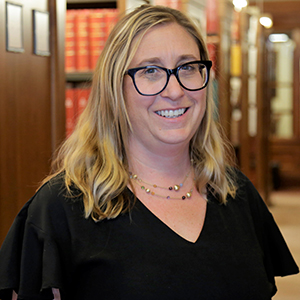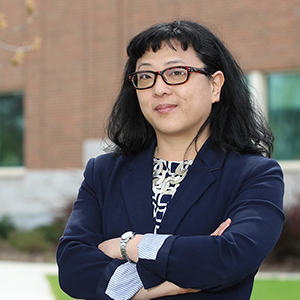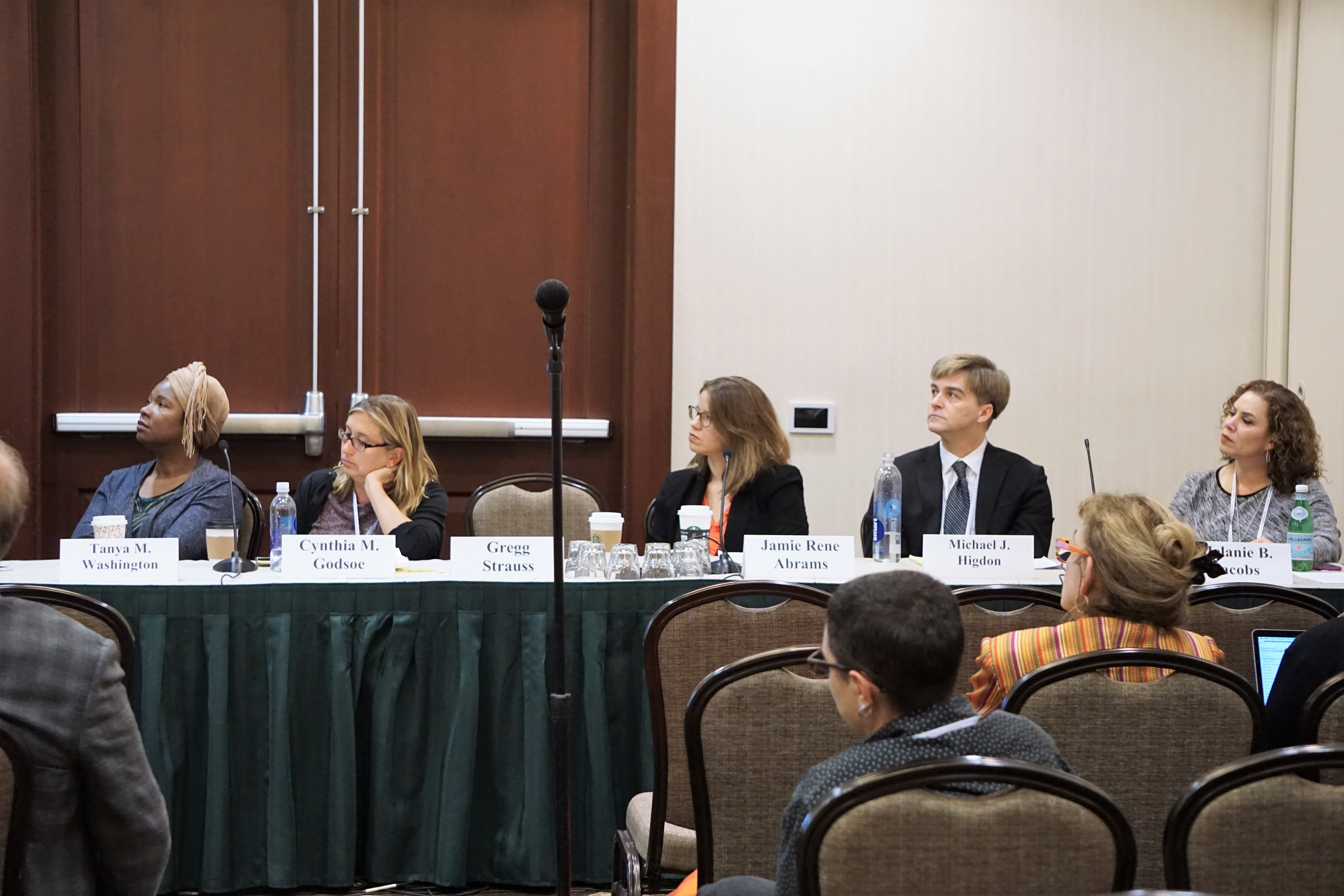AALS sections provide opportunities for law school faculty and staff to connect on issues of shared interest. Each of the associations 104 sections is focused on a different academic discipline, affinity group, or administrative area. For a full list of sections and information on how to join, please visit www.aals.org/sections.
As part of the ongoing “Spotlight on Sections” series, AALS sat down with the leadership of the Section on Family and Juvenile Law for a Q&A.
The Section on Family and Juvenile Law promotes the development and exchange of information relating to teaching and research in the fields of family and juvenile law and promotes collaborative action among those individuals having an interest in these fields.
Chair: Cynthia M. Godsoe, Brooklyn Law School
Chair-Elect: Kim Hai Pearson, Gonzaga University School of Law


Cynthia Godsoe: Our membership is large with a wide range of people who have been teaching for decades to people new to teaching, to people who teach legal writing, to a fair number of people who teach in clinics. It is great to have a mix of perspectives. There is also a broad geographic range including a few international members.
CG: Marriage equality was and continues to be a big issue. In broad terms, non-traditional families, like non-marital families and LGBTQ families, are big topics in the field. Discussion about different types of parenting is changing the field dramatically. In juvenile law, there is juvenile justice and immigration.
Kim Pearson: One of the big things we are talking about for children is trauma-informed care. If children are being protected by their parents or the state, many of those protections fall short of what kids need. I think as we move into a more global community and interact more across different groups, we will see alternative families that fall out of the mainstream idea of familyhood. I think this is an exciting and pressing area of interest.
CG: Equality is a huge issue in childhood, birth, and access to reproductive freedom. That is a huge concern going forward: how different kinds of families and children are treated differently by the state in illegitimate ways.
KP: Not the exact numbers, but at schools in the mid- and low-range based on the US News ranking, about 40-60 percent of the graduates will practice family law at some point in their career. The more rural your school is, the more likely your graduates will be going into family law. It is difficult to be exact because many small- and mid-size firms may concentrate in several areas within family law, but they may not call themselves a family law practice.
CG: At my school, a significant percentage go into family and juvenile law. It is one of the most popular classes because it is seen as relevant even if a student doesn’t plan to practice in the area. One of the things we focus on during pedagogy panels is better connecting the classroom and practice. Jessica Dixon Weaver, the 2018 section chair, is coming out with a book of simulations that we’re all excited to use because it is so related to practice.
CG: My other area is criminal law, so I just wrote a symposium piece about the #MeToo movement and some of its downsides including juveniles who are prosecuted for sex offenses—which is about a quarter of the people on the sex offender registry. I am also working on a piece about deincarceration and decriminalization in general. Juveniles are a large and particularly problematic piece of it, but it is also particularly promising because there is Supreme Court jurisprudence that juveniles can be charged at a lesser degree. I think that’s one wedge into reducing the carceral state: stopping the prosecution of juveniles for fairly normal juvenile behavior.
KP: I am working on domesticating the Convention on the Rights of the Child in the United States through family law courts. A follow-up piece to that will look at identity in the international realm as a theoretical framework for understanding identity in the U.S. so we can better protect constitutionally-protected identities for children in the U.S. A third piece I am starting is the art of suffering and trauma. I’m talking about kids in detention center camps and other places that have experienced crimes against humanity, the artwork that comes from that, and the role of art in advocating for legal reform.
KP: One big change is more emphasis on experiential learning. The way family law is taught and tested on the bar tends to focus more on family law as a subset of constitutional law, as opposed to the micro-world of family law practice. It’s aimed at the macro-level of trends happening in families across the country. What are the relationships between the state and the individual or couples? Having a mix of macro and micro through experiential learning is thrilling, I think.
I think [family law is] one of the most radical and interesting places to explore changes that anticipate what will happen in other areas of constitutional law. I think it’s fair to say that family law in general is under-theorized but is now hitting its stride. The field has shifted from the traditional idea of divorce and child custody to intersecting and cross-cutting topics.
Going back to the teaching question, our students are growing up as digital natives. They want to interact more and are not content to passively accept information. That is a challenge and an opportunity to reach our students in new ways.
KP: Even in the short time I’ve been teaching, family law has gone from a class where you teach people how to divorce and divide up custody, which is very practical and skills-based, to being much more theoretical, influenced by social science and other kinds of critical thinking. It’s become more inclusive and shifted to include views about income status, abilities, gender, and race. The picture we can show in case law and the way we present ideas about the law interacting with family is completely different. We have a more holistic view of families and individuals as being touched by the law in many places. Family law is everywhere. Through every time in a person’s life, there is some way in which family law touches them. Siloes are helpful in that we can say very quickly what our specialty is, but it’s misleading in that law is very holistic.
KP: The easiest example is marriage equality. Over the last 50 years, parenting equality cases have changed the way we think about parenting. In court, you make decisions about the family at hand rather than sweeping social changes in a family’s lives. You’re dealing with people on the micro-level. Most of the time, you need to figure out what is in the best interest of the child. So, in the past, people had said same-sex parenting is dangerous to children. But over time, they started to see that same-sex parents are not only just as good, but in some cases better. When the question of marriage equality came up on the national scale, people would say things like “what about the children?” And the court could look at the parenting equality cases and see the kids were just fine, which boosted marriage equality activism. People could say that not only were the kids fine, but if that was the only reason stopping marriage equality, then it just wasn’t a good enough reason anymore.
 Section on Family and Juvenile Law session at the 2019 AALS Annual Meeting.
Section on Family and Juvenile Law session at the 2019 AALS Annual Meeting.
When you make these changes over time on the micro-level, it flies under the radar until people need a data set or a prediction of how society will go forward. That’s why we’re so interested in the erosion of civil rights for children and families at the margin: children with disabilities, who are homeless, children of migrant laborers or undocumented immigrants. What does this tell us about how we will treat them when they’re in the country? There are complicated relationships not just with the parents and the state, but also with the state and the children. It’s unknown and complex. You get to see change in a lifetime, whereas in many areas of law, change does not happen so quickly.
KP: This is a two-part answer. The first is that the United States was one of the main drafters of the Convention on the Rights of the Child, which is one of the core human rights conventions that every other country ratified. We embedded a lot of ideas about traditional heteronormative nuclear families into this document. It’s been 20 years, and we still haven’t ratified it. This has influenced our role internationally because it makes it seem like we want people to behave in a certain way but refuse to be beholden to those standards. It’s problematic.
The second part is that the one main intersection of international law and domestic law that is really about children: the Hague Convention on children which looks at adoption or children being stolen. More people are seeing that as part of family law, as we see family law touch on immigration and trafficking both internationally and within the U.S. It’s a wonderful time to be in family law because we’re starting to make more connections in scholarly circles and in advocacy circles. I’m very optimistic.
KP: The section is one of my favorite and most engaged groups that I work with. People are friendly, supportive, and share resources. We meet a lot and do social events, and we stay in touch online. At one point we were even doing a book club and discussion.
We do a lot of informal mentoring, and we have a great network. There are a number of us who moved over from the Feminist Legal Theory Group and the Family Law Scholars and Teachers group. Those groups have had formalized, structured panels with assigned mentors and junior scholars. We want to move toward that in our section. The model works, and it helps people who are often isolated. It gives you an instant community.
KP: We’ll have our business meeting on Friday morning, then we’ll do our main program about the erosion of civil rights. We’ll do our pedagogy panel in the afternoon on Saturday. Both Cynthia and I are big supporters of the teaching portion of our program. We don’t believe in the hierarchy of substance over teaching. They’re not mutually exclusive; they build on each other.
One of my big concerns is making sure that we pay attention to diversity of all kinds. For our main program, I reached out to Minority Groups and Civil Rights and make sure we got several groups involved to address issues like LGBTQ children, foster kids, and children in detention centers. We are also looking at criminal justice, juvenile justice, and families in general.
This year, we applied for and were awarded a generous scholarship and were able to invite a non-law speaker. Dr. Wong is a pediatrician at Stanford who has been part of a team that interviews children in detention centers for trauma, then reports to Congress about the impacts the detention centers are having on children. Having that perspective in our group will make it extra special. We try to make sure we have people who have never presented at AALS before. We also did a call for papers, so we have a mix of people. We’re thinking of setting it up as a round table—we’ll have a set of directed questions, but most of the time it will be a free-flowing open discussion with audience participation. I think the real magic happens when everyone is generating new ideas and new ways to think about the bigger issue.
CG: I feel good about the programs we have. I think teaching is underexplored at professional events, so the pedagogy program is helpful for members. When so much of the focus at many schools is outside of teaching, people don’t get the support they need. I am glad that we have been able to do more of that recently.
In the future, I’d like to see more in terms of mentoring. I’m on the board of the criminal justice section, which has a works-in-progress program with mentor-mentee pairs, so people can actually get together to talk about the newer member’s scholarship. I think our section should do that in future years. We have an informal mentoring program, but it has never culminated in a concrete session.
KP: I would like to support Cynthia’s vision of mentorship, and I would also like that to include reaching out to more international scholars.